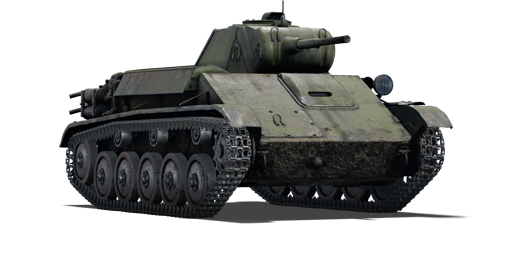



The T-70 was a Soviet tank developed from the preceding T-60 light tank. The T-70 replaced the T-60 in the role of reconnaissance tank as well as replacing the T-50 in the role of infantry support. The hull armour of the T-70 stayed the same as the T-60s, however a new turret featuring the 45 mm 20-K gun was installed with 50 mm thick armour at the front and 35 mm on the sides and back of the turret. The T-70 was designed by N. Astrov, the designer of the previous T-60 light tank at Factory No.38 in Kirov. The T-70 was powered by two automobile GAZ-202 engines which were placed on each side of hull, this proved problematic and after a few dozens were made, the engines were moved in-line on the right side of the hull. The conical turret was also replaced by a welded one allowing for easier production and moved to the left side of the hull. On 6th July 1943, Lieutenant B.V. Pavlovich destroyed four german tanks, three medium tanks and one Panther near the village of Pokrovka. On 26th March 1944, Sergeant Alexander Pegov ambushed a column of approximately 18 German tanks singlehandedly and took out one Panther, and immobilized another. The T-70 retreated and Pegov was promoted to a lieutenant and received the Hero of the Soviet Union award, the highest Soviet Military award at that time. The T-70s remained in service until 1948 and served as a basis for the SU-76 tank destroyer and ZSU-37 self-propelled anti-aircraft gun.
The T-70 was introduced during the Closed Beta Test for Ground Forces before Update 1.41. The T-70 is an upgunned T-60 tank, it shares the same two crew layout, meaning any penetrating hit will be fatal. The armour itself offers good protection due to its sloping, although HEAT-equipped cannons like those found on the German Pz.IV F1 or high velocity guns such as the PaK 36(r) found on the Marder tank destroyer have no issue penetrating the armour and destroying the T-70 in single hit. The T-70 is capable of penetrating nearly all its opponents with few exceptions such as the Matilda III. Flanking should still be the primary playstyle of the T-70, as it excels in ambushing due to its small size and low silhouette.
| Ammunition | Type | Armor penetration (mm) at a distance: | |||||
|---|---|---|---|---|---|---|---|
| 10 m | 100 m | 500 m | 1000 m | 1500 m | 2000 m | ||
| APHEBC | 70 | 67 | 58 | 47 | 39 | 32 | |
| APBC | 73 | 70 | 60 | 50 | 41 | 34 | |
| APCR | 94 | 87 | 64 | 43 | 29 | 20 | |
| Belt | Belt filling | Armor penetration (mm) at a distance: | |||||
|---|---|---|---|---|---|---|---|
| 10 m | 100 m | 500 m | 1000 m | 1500 m | 2000 m | ||
| AP-I/API-T | 13 | 12 | 7 | 3 | 2 | 0 | |












Mobility | |
|---|---|
Protection |
|---|
Firepower | |
|---|---|